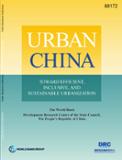Urban China: toward efficient, inclusive, and sustainable urbanization
 In the last 30 years, China’s record economic growth lifted half a billion people out of poverty, with rapid urbanization providing abundant labor, cheap land, and good infrastructure. While China has avoided some of the common ills of urbanization, strains are showing as inefficient land development leads to urban sprawl and ghost towns, pollution threatens people’s health, and farmland and water resources are becoming scarce. With China’s urban population projected to rise to about one billion – or close to 70 percent of the country’s population – by 2030, China’s leaders are seeking a more coordinated urbanization process. Urban China is a joint research report by a team from the World Bank and the Development Research Center of China’s State Council which was established to address the challenges and opportunities of urbanization in China and to help China forge a new model of urbanization. The report takes as its point of departure the conviction that China's urbanization can become more efficient, inclusive, and sustainable. However, it stresses that achieving this vision will require strong support from both government and the markets for policy reforms in a number of area.
In the last 30 years, China’s record economic growth lifted half a billion people out of poverty, with rapid urbanization providing abundant labor, cheap land, and good infrastructure. While China has avoided some of the common ills of urbanization, strains are showing as inefficient land development leads to urban sprawl and ghost towns, pollution threatens people’s health, and farmland and water resources are becoming scarce. With China’s urban population projected to rise to about one billion – or close to 70 percent of the country’s population – by 2030, China’s leaders are seeking a more coordinated urbanization process. Urban China is a joint research report by a team from the World Bank and the Development Research Center of China’s State Council which was established to address the challenges and opportunities of urbanization in China and to help China forge a new model of urbanization. The report takes as its point of departure the conviction that China's urbanization can become more efficient, inclusive, and sustainable. However, it stresses that achieving this vision will require strong support from both government and the markets for policy reforms in a number of area.
